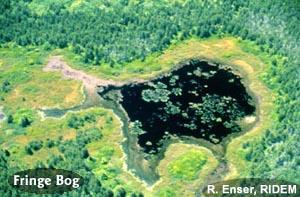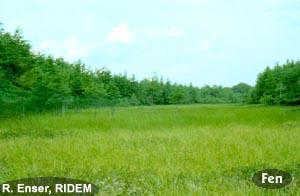Bogs

Bogs are relatively uncommon in Rhode Island. They are distinguished by floating mats of Sphagnum (Sphagnum sp.) moss that "quake" when walked upon.
Bogs form in isolated depressions that continuously hold water, or as fringes along the shores of ponds. Due to the constant presence of water dead plants are not able to decay and plant fibers accumulate as "peat" which becomes thicker over time, hence filling the basin and providing the base for the quaking mat. The constant saturated condition of the peat creates an environment that is difficult for plants to grow in. Trees, such as cedar or spruce, growing on the edges of bogs, may be dwarfed from the wet, low nutrient environment. Pitcher plants (Sarracenia purpurea) and sundews (Drosera) are examples of plants with special adaptations for survival in the harsh bog environment. They are carnivorous and are able to trap and digest insects to obtain necessary minerals missing from the soil. Other plants commonly found in bogs include blueberry (Vaccinium corybosum), leather leaf (Chamaedaphne thyoides), sweet gale (Myrica gale) and Cranberry (Vaccinium sp.).

Fens differ from bogs in that they have very little Sphagnum moss and they may be seasonally flooded.
